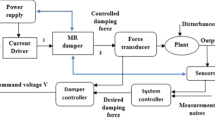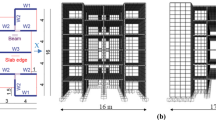Abstract
Blast-induced dominant vibration frequency (DVF) involves a complex, nonlinear and small sample system considering rock properties, blasting parameters and topography. In this study, a combination of grey relational analysis and dimensional analysis procedures for prediction of dominant vibration frequency are presented. Six factors are selected from extensive effect factor sequences based on grey relational analysis, and then a novel blast-induced dominant vibration frequency prediction is obtained by dimensional analysis. In addition, the prediction is simplified by sensitivity analysis with 195 experimental blast records. Validation is carried out for the proposed formula based on the site test database of the firstperiod blasting excavation in the Guangdong Lufeng Nuclear Power Plant (GLNPP). The results show the proposed approach has a higher fitting degree and smaller mean error when compared with traditional predictions.
Similar content being viewed by others
References
Ak H and Konuk A (2008), “The Effect of D iscontinuity Frequency on Ground Vibrations Produced from Bench Blasting: A Case Study,” Soil Dynamics and Earthquake Engineering, 28(9):686–694.
Bellamine FH and Elkamel A (2006), “Numerical Characterization of Distributed Dynamic Systems Using Tools of Intelligent Computing and Generalized Dimensional Analysis,” Applied Mathematics and computation, 182: 1021–1039.
Borenstein E and Benaroya H (2009), “Sensitivity Analysis of Blast Loading Parameters and Their Trends as Uncertainty Increases,” Journal of Sound and Vibration, 321: 762–785.
Bridgman P (1922), Dimensionsal Anaylsis, New Haven: Yale University press.
Chen SG and Zhao J (1998), “A Study of UDEC Modeling for Blast Wave Propagation in Jointed Rock Masses,” International Journal of Rock Mechanics and Mining Sciences, 35(1):93–99.
Fan XF, Zhou CB and Chen GP (2005), “The Influential Factors of Blasting Vibration by Grey Correlation Analysis,” Blasting, 22(2):100–102.
Jiao YB (1995), “Research on the Standard of Blasting Seismic Safety Assessment,” Blasting, 12(3):45–47.
Kahriman A (2004), “Analysis of Paramete rs of Ground Vibration Produced from Bench Blasting at a Limestone Quarry,” Soil Dynamics and Earthquake Engineering, 24(11):887–892.
Khandelwal M and Singh TN (2005), “Prediction of Blast Induced Air Overpressure in Opencast Mine,” Noise & Vibration Worldwide, 36: 7–16.
Khandelwal M and Singh TN (2006), “Prediction of Blast Induced Ground Vibrations and Frequency in Opencast Mine: A Neural Network Approach,” Journal of Sound and Vibration, 289(4–5): 711–725.
Langhaar H (1951), Dimensional Analysis and Theory of Models, 1st ed. New York: Wiley.
Li HB, Jiang HJ, Zhao J et al. (2003), “Some Problems about Safety Analysis of Rock Engineering under Dynamic Load,” Chinese Journal of Rock Mechanics and Engineering, 22(11):1887–1891.
Li JC, Li HB, Ma GW and Zhou YX (2013), “Assessment of Underground Tunnel Stability to Adjacent Tunnel Explosion,” Tunnelling and Underground Space Technology, 35: 227–234.
Li JC, Ma GW and Zhou YX (2012), “Analytical Study of Underground Explosion-induced Ground Motion,” Rock Mechanics and Rock Engineering, 45(6):1037–1046.
Li XL, Mu TS et al. (2001), “Role of Frequency in Harm of Blasting Vibration and Analysis on Its Influence Factors,” Engineering Blasting, 7(3):15–18.
Liu LQ and Katsabanis PD (1997), “Development of a Continuum D amage Model for Blasting Analysis,” International Journal of Rock Mechanics and Mining Sciences, 34(2):217–231.
Lu WB, Zhang L et al. (2013), “Theoretical Analysis on Decay Mechanism and Law of Blasting Vibration Frequency,” Blasting, 30(2):1–6.
Meng HL and Guo F (2009), “Experimental Research on the Master Frequency of Blasting Seismic Wave,” Journal of Railway Engineering Society, 11(11):81–83.
Mohammadnejad M et al. (2012), “Prediction of Blast-induced Vibrations in Limestone Quarries Using Support Vector Machine,” Journal of Vibration and Control, 18(9):1322–1329.
Sadovskij MA (1966), “Evaluation of Seismically Dangerous Zones in Blasting, Seismic Institute of the Academy of Sciences, In: On the effects of blast-induced Vibrations,” Bulletin of Subalpina Mining Association.
Singh PK and Roy MP (2010), “Damage to Surface Structures due to Blast Vibration,” International Journal of Rock Mechanics and Mining Sciences, 47(6):946–961.
Siskind DE (1980), “Structure Response and Damage Produced by Ground Vibration from Surface Mine Blasting,” USA: US Bureau of Mines.,:74–78.
Wang P, SL Jones et al. (2013), “Sensitivity Analysis of Key Input Param eters in Conditional Cell Transmission Model for Oversaturated Arterials,” Journal of Central South University, 20(6):1772–1780.
Wu CQ, Lu Y and Hao H (2004), “Numerical Prediction of Blast-induced Stress Wave from Large-scale Underground Explosion,” International Journal for Numerical and Analytical Methods in Geomechanics, 28(1):93–109.
Xue XH, Yang XG and Zhang WH (2014), “Numerical Modeling of Arch Dam under Blast Loading,” Journal of Vibration and Control, 20(2):256–265.
Yang R, Bawden WF and Katsabanis PD (1996), “A New Constitutive Model for Blast Damage,” International Journal of Rock Mechanics and Mining Sciences & Geomechanics Abstracts, 33(3):245–254.
Zhang LG and Yu YL (2005), “Research on the Relationship of Main Vibration Frequency of Blasting Vibration and Peak Particle Velocity,” Nonferrous metals (Mine Section), 57(4):32–34.
Zhang SX, Yang MG, Yin JG et al. (2000), “An Empirical Formula of Calculating the Vibrating Intensity of Explosive Wave and Its Application in Mining,” Blasting, 17(3):13–17.
Author information
Authors and Affiliations
Corresponding author
Additional information
Supported by: National Natural Science Funds for Distinguished Young Scholar under Grant No. 51009086, Hubei Key Laboratory of Roadway Bridge and Structure Engineering under Grant No. DQJJ201313 and Major State Basic Research Development Program of China (973 Program) under Grant No. 2010CB732001
Rights and permissions
About this article
Cite this article
Li, H., Li, X., Li, J. et al. Application of coupled analysis methods for prediction of blast-induced dominant vibration frequency. Earthq. Eng. Eng. Vib. 15, 153–162 (2016). https://doi.org/10.1007/s11803-016-0312-6
Received:
Accepted:
Published:
Issue Date:
DOI: https://doi.org/10.1007/s11803-016-0312-6




